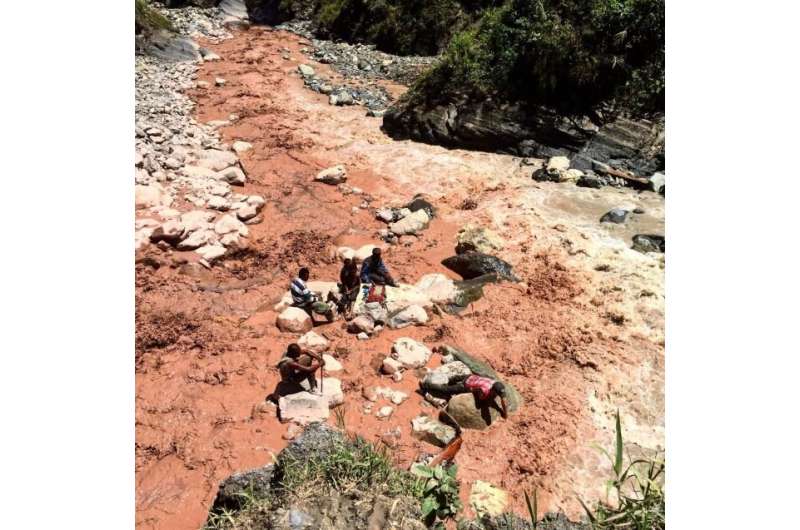Study co-author Joshua Fisher (lower right) collecting water samples from treated mine tailings. Credit: Joshua Fisher
A new study examines how acidity and climate impact arsenic removal strategies downstream of the Porgera Joint Venture gold mine in Papua New Guinea.
Published November 11 in Applied Geochemistry, the study focuses specifically on arsenic capture and storage by soil and sediments—a process called sequestration. Mine waste contains arsenic, and if that arsenic is not captured by the soil, it remains dissolved in water, where it poses health risks to people and ecosystems. The study investigated the mechanisms through which sediments in the mine-impacted area are able to sequester arsenic, and how mine wastes should be handled in order to prevent arsenic from being transported downstream.
In particular, the researchers—led by Beth Hoagland from the University of Pennsylvania —examined how pH and climate patterns, specifically wetting and drying cycles, impact arsenic sequestration.
An important finding from this work is that treating mine tailings with lime helped stabilize arsenic in the sediments. Given the tropical climate of the Porgera Watershed, the study also tested the impacts of wetting and drying the mine tailings that had been treated with lime. These tests indicated that the treated mine wastes rapidly released arsenic during rewetting, but the amount of arsenic released from the wastes decreased over time following repeated wetting and drying cycles. This study emphasizes how important it is for the Porgera Joint Venture to continue to treat tailings with lime to reduce arsenic mobility in the watershed.
The results are critical for understanding future environmental and social impacts of mining and tailings treatment procedures, particularly in an area that is vulnerable to increased climate variability.
The findings are timely, as the future of the Porgera mine lease and its ongoing operations are currently being reconsidered by the government of Papua New Guinea. In 2019, the mine operator's lease expired, and in April 2020, Papua New Guinea's Prime Minister James Marape refused to renew the lease with operator Barrick Niugini Ltd, citing environmental and social issues. Negotiations are still ongoing, but it appears that Barrick Niugini Ltd will continue to operate the mine in the future.
The mining industry and government regulators around the world are similarly grappling with questions of whether and how to mitigate the environmental impacts of both ongoing and legacy operations. These results highlight the importance of carefully considering contaminants in mine closure and remediation plans, especially in light of rights to water.
This study was conducted in support of a joint initiative between Columbia University's Advanced Consortium on Cooperation, Conflict, and Complexity (AC4), the Human Rights Law Clinic at Columbia Law School, and researchers formerly of Penn State. The initiative examines access to clean water and sanitation in Porgera.
The larger project work in Porgera dates back to 2015, when a team of scientists and human rights lawyers including AC4 Director Josh Fisher, Professor Sarah Knuckey from Columbia Law School, and Professor Tess Russo from Pennsylvania State University started an interdisciplinary study on the right to water in Porgera. Over the course of four years, the team analyzed the water around the mine and conducted qualitative interviews with those impacted by the mining activities. This work culminated with the study Red Water, which included recommendations for the owners of the mine, local government and others.
More information: Beth Hoagland et al. Arsenic sequestration in gold mine wastes under changing pH and experimental rewetting cycles, Applied Geochemistry (2020). DOI: 10.1016/j.apgeochem.2020.104789
Provided by Earth Institute at Columbia University
This story is republished courtesy of Earth Institute, Columbia University http://blogs.ei.columbia.edu.
























